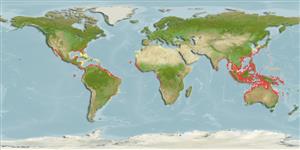Issue
This species was not reported since the 19th century in the Mediterranean Sea. An award will be granted by the CIESM to any documented, reliable / verifiable evidence (published paper / Ph.D thesis / photo) reporting the species after that date (Ref. 116564).
Environment: milieu / climate zone / depth range / distribution range
Ecologie
marien; zoet water; brak water demersaal; oceanodroom (Ref. 51243); diepte 25 - ? m (Ref. 114953). Subtropical; 35°N - 40°S, 120°W - 160°E (Ref. 114953)
Circumglobally in tropical and subtropical waters, entering estuaries and littoral lagoons and ascending river courses (Ref. 81284, 81624). Western Atlantic: Florida and Louisiana, USA to Brazil (Ref. 7251); eastern Atlantic: Portugal to Angola, including the western Mediterranean Sea (Ref. 4429; no report since the 19th century [Ref. 116564] ); western Pacific: northern Australia, from western Australia to Queensland (Ref. 7300); eastern Pacific: Gulf of California to Ecuador (Ref. 4429). In freshwater it can be found in rivers of West Africa (Ref. 81284), Ogowe River (Ref. 81284) and the Congo River estuary (Ref. 377, 81284).
Lengte bij maturiteit / Grootte / Gewicht / Leeftijd
Maturity: Lm 300.0, range 300 - 300 cm
Max length : 750 cm TL mannelijk / geslacht onbekend; (Ref. 57708); common length : 250 cm TL mannelijk / geslacht onbekend; (Ref. 4429); max. gerapporteerde leeftijd: 30 Jaren (Ref. 57533)
Diagnosis: Rostral blade with 20 or fewer pairs of rostral spines (Ref. 81624).
A euryhaline species (Ref. 57533). Inhabits inshore coastal waters to moderate depth, also around off lying islands. Found also in estuaries, lagoons, river mouths, and even freshwater. Feeds on fishes and bottom-living animals. Ovoviviparous. Apparently can reproduce in freshwater (Ref. 57533). Freshwater populations occur to about 750 km up Amazon River; populations in Lake Nicaragua may be non-migratory (Ref. 7251). Reaches sexual maturity at 8-10 years and females have litters of approximately 1-13 pups. Young spend much of their early life in rivers up to 400 km from the sea (Ref. 114953).
Levenscyclus en paargedrag
Maturities | Voortplanting | Spawnings | Egg(s) | Fecundities | Larven
Ovoviviparous, embryos feed solely on yolk (Ref. 50449).
Stehmann, M., 1990. Pristidae. p. 51-54. In J.C. Quero, J.C. Hureau, C. Karrer, A. Post and L. Saldanha (eds.) Check-list of the fishes of the eastern tropical Atlantic (CLOFETA). JNICT, Lisbon; SEI, Paris; and UNESCO, Paris. Vol. 1. (Ref. 4429)
Status op de Rode Lijst van het IUCN (Ref. 130435)
Gevaar voor de mens
Harmless
Gebruik door de mens
Visserij: van minder commercieel belang
Tools
Speciale rapporten
Download XML
Internetbronnen
Estimates based on models
Preferred temperature (Ref.
123201): 20.1 - 29.1, mean 27.8 °C (based on 1796 cells).
Fylogenetische diversiteitsindex (Ref.
82804): PD
50 = 0.5234 [Uniqueness, from 0.5 = low to 2.0 = high].
Bayesian length-weight: a=0.00501 (0.00198 - 0.01270), b=3.05 (2.83 - 3.27), in cm total length, based on LWR estimates for this (Sub)family-body shape (Ref.
93245).
Trofisch niveau (Ref.
69278): 4.0 ±0.60 se; based on food items.
Weerstandsvermogen (Ref.
120179): laag, minimale populatieverdubbelingstijd 4,5-14 jaar (tmax=44; Fec=1-20;).
Fishing Vulnerability (Ref.
59153): Very high vulnerability (79 of 100).
Nutrients (Ref.
124155): Calcium = 8.73 [1.69, 40.68] mg/100g; Iron = 0.523 [0.130, 1.505] mg/100g; Protein = 20.3 [18.1, 22.3] %; Omega3 = 0.173 [0.070, 0.432] g/100g; Selenium = 37 [10, 113] μg/100g; VitaminA = 2.11 [0.72, 6.06] μg/100g; Zinc = 0.367 [0.179, 0.703] mg/100g (wet weight);
